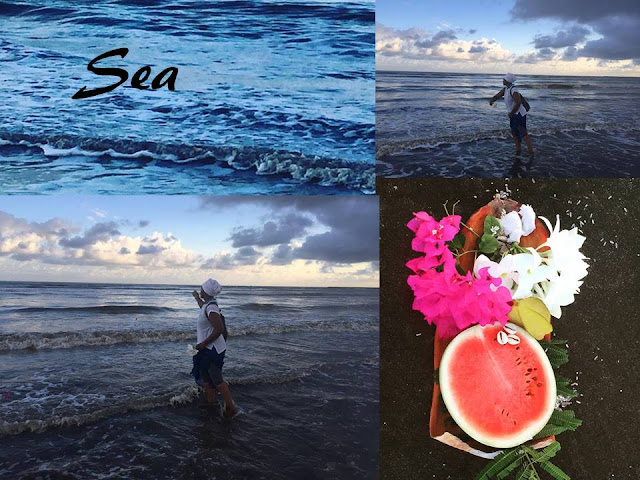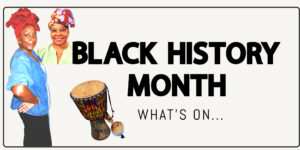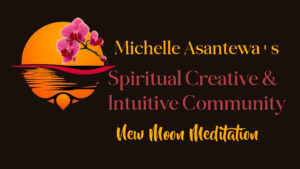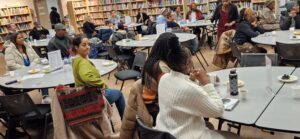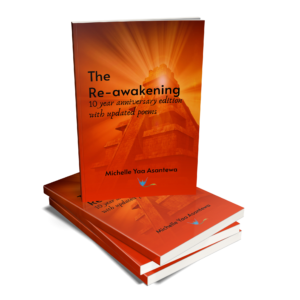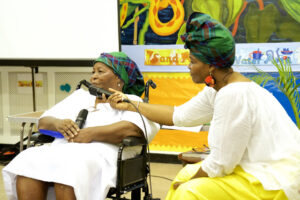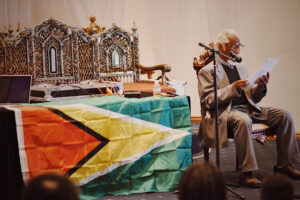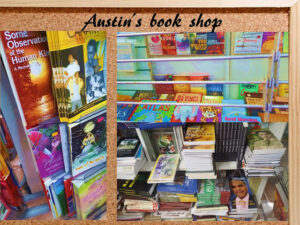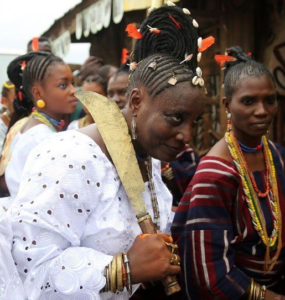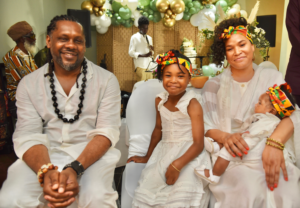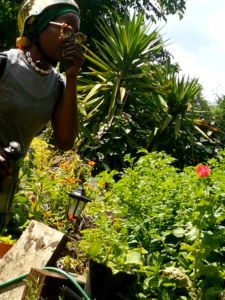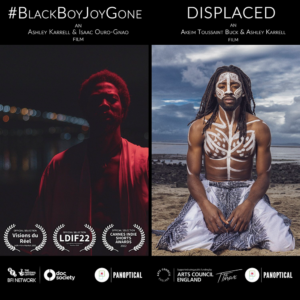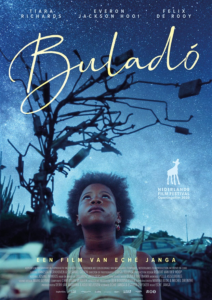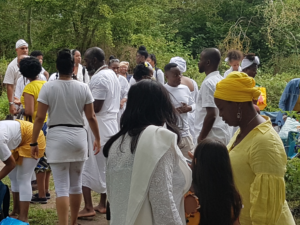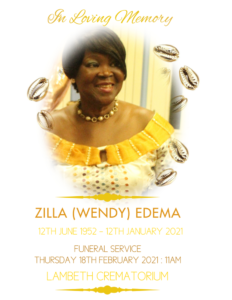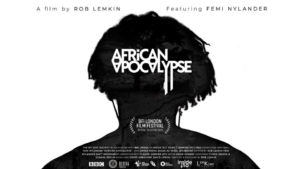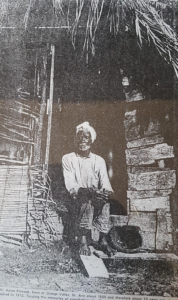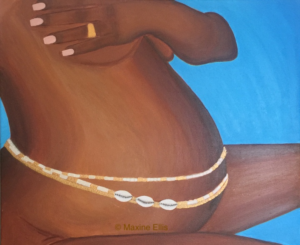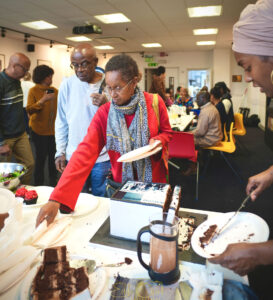
Disclaimer: Use of Copyrighted Images
The images used on this
blog and in our newsletters are sourced for educational purposes only.
These images are the property of their respective copyright holders and
are used under the principle of *fair use* to support commentary,
analysis, and discussion. We make no claim of ownership over any
copyrighted images and have taken all reasonable steps to attribute them
appropriately.
If you are the copyright owner of any image
featured here and believe it is being used improperly, please contact us
directly. We are committed to respecting intellectual property rights
and will take prompt action to resolve any concerns.
This content
is not intended for commercial use, and any reproduction or
distribution of the images without proper authorization may violate
copyright laws.
Guyana travels: September – October 2017
-
 By
Dr Michelle Yaa Asantewa
By
Dr Michelle Yaa Asantewa
- 9 minutes
- SiteNews
Share
A few years ago I discovered something interesting about myself. I have the planet Jupiter in the 12th house of my birth chart. I must have known this for much longer but had no idea or hadn’t taken time to consider what it meant. Although interpretations vary about the significance of the 12th house, it is supposed to represent, among other things, challenges — masked as mysteries, secrets and so on that must be overcome in our lives. It is also said to reflect the subconscious — even the collective unconscious — hence it relates to deeper ventures of the mind and purpose of being. So challenges in this context might be best understood as our endeavours to know self, to transform self, to journey (not merely physically) but to the subconscious where the hidden secrets about our purpose might reveal themselves. If Jupiter sits in this house, however, it’s believed the individual will experience some protection against these challenges or rather experience the apparent challenges in a more spiritually expansive way. You see, Jupiter is meant to be a lucky planet. I’ve never thought myself lucky. Yet the discovery made me rethink how I do see myself and how I define luck.
Here’s one of the ways astrologer Donna Cunningham describes luck:
“Luck is growth and wisdom gained from experience.” I agree and go further. The growth and experience from which luck is derived make possible our ability to manifest Divine Order. It’s when the vision board comes alive and in ways beyond our imagination. Visualisation and meditation are key aspects of this astrological fixture in a birth chart. But it’s easy to say and know this than to realise it. I have learnt the importance of making preparations — carefully putting things in place and waiting. But often I become impatient and try to hurry up the kindling process (‘waiting’), the Divine Timing that accompanies the Order.
The last time I visited Guyana was in 2013. I went with my niece for whom it was the first time visiting the country of her father’s birth. The trip was mostly burdened by overt racism and some cultural restraints that made our time there patchy to say the least. That time I didn’t intend to do any rituals but would visit the sea to make offering as usual. After some sticky experiences it dawned on me we hadn’t given full homage to the ancestors but had embarked on the journey as though my nativity wasn’t connected to those who went before. I stopped the madness, did obeisance and things moved much more smoothly thereafter. The tide (our luck) turned.
At the forefront of the plans to go to Guyana this year, which marked Guyana’s 50th Independence, was that very connection to my ancestors. We had published three new books that honoured Guyanese folk culture and spiritual traditions. These were launched in London in July but we planned to launch them in Guyana too, for this would be a kind of return to source. It was a tribute, if you like to the ancestors who inspired my work on Komfa and some aspects of my spirituality.
Finally, I had a Jupiterian dream to organise a spiritual and cultural arts festival in Guyana, which was shared with flautist Keith Waithe and would link to the annual Rupunnuni Festival. This latter was cancelled and my dream deferred but is not deterred. Instead I planned to do smaller rituals to honour the spirits of my ancestors and the wider ancestors of the land.
My mother, Mama Lou — the biographic subject of one of the books would make the trip too, despite physical challenges to her ability to walk. It would be Ateinda’s first visit to Guyana – he hoped to do some sightseeing and a chance for Cheryl (another travelling companion) to reconnect with friends and family.
Our trip to Guyana this year was timely and fortuitous, expressing the expansion (spiritual and real) associated with Jupiter. I’ve tried to capture some of the experiences in the picture collages below, commenting lightly to allow the pictures to give the impression of how wonderfully manifest were the Timing and Order, indeed how beyond my imagination the vision board materialised.
There’s one foremost bookshop in Georgetown (if not Guyana), Austin’s in Church Street. I had sent the first books we published to be sold there. That was nearly two years ago – they had not sold any. They had never contacted me, despite my trying to get in touch (via email) to find out progress with the books. When I arrived I went to the shop (it happens to be around the corner from where I was staying). I spotted copies of The Awakening in one of the stands, but couldn’t locate Elijah . After about half hour of searching with the shop staff, I eventually found the books in a location near the ‘religious writings.’ I was told that the staff probably saw the title and didn’t read much more beyond that to know where to stock the book. They eventually moved the books into the ‘local writers’ section where The Awakening was. I saw some other books in that section that I recognised were written by UK based Guyanese writers – Peter Ramrayka’s was one of these. Margaret Andrew’s biography of Jessica and Eric Huntley, Doing Nothing is Not an Option , was also there. The books throughout the shop were woefully disorganised or dishevelled. Many of the prominent books as you entered the shop were of big names/stories like Harry Potter . The outside window display featured a number of religious books. The books are overpriced. As a result I was told by my cousin that parents and students used a service where books were photocopied – given the dubious copyright laws in Guyana. I am glad Austin’s exists so that original texts could be found there. If only the organisation was tighter, communication better and resources to open other shops in the country were available this would be a greater contribution. The staff were generally friendly and approachable. Writers in the diaspora should stay close to this shop and try to monitor how our book sales are doing as well as be fairer about how much is charged for our books, taxes and shipping allowing.
The launch was held at Moray House and was co hosted by us (Way Wive Wordz) and The University of Guyana. The programme above outlines the order of the evening – it was a much more formal process (at least initially intended to be thus) than the one we did in London. It was customary by University professors/lecturers to review books when they were hosting a book launch. Given that we were launching three (!), there required three book reviews. Mr Al Crieghton gave a great overview of Guyanese Komfa ; Ms Gential Miller reviewed Mama Lou Tales and Ramona Bennett’s excellent review of Something Buried in the Yard was published in Stabroek News , on November 27th following our return. I had met Dr Barbara Reynolds, the Deputy Vice Chancellor when she visited London with Professor Ivelaw Griffith, the Vice Chancellor of the University of Guyana in August (I think) and we agreed to organise the launch. I was grateful both had kept their word.
My young cousin, 12 year old Julia, unfazed by the Creole in Mama Lou Tales volunteered to read a couple of the Tales. We had planned for her mother, Adi to read but Julia loved the stories as they were practicing and decided she would read. That was a very special thing. Whilst many struggle to read Creole (and I often to write it no doubt!), this young lady read it beautifully, calling into question why more of this is not taught in the schools or more such books used in the curriculum (discussed a bit more below). Here’s Julia’s reading…the Guitar Player
Moray House reached capacity of 70 people. We were grateful for everyone who took time to attend, especially members of the family who travelled from Berbice and some we hadn’t seen for some time. As well as those faculty and university of Guyana members, we were pleased to see Minister Carl Greenwich and Mr Lincoln Lewis join us.
SCHOOLS IN!
A particular highlight was visiting a few secondary schools where I read from my first novel Elijah . The children were amazing. It was unfortunate many struggled to name Guyanese writers. They tended to know of Martin Carter. That was it! One of the Heads explained that the CXC curriculum doesn’t really use literature by Guyanese authors. If this is true – its shameful and surely the Guyanese Ministry of Education will try to fix this, given the contributions to literature made by Guyanese over the years in the discipline of literature. What ever the reasons etc, I was disappointed that the students when prompted couldn’t name Guyanese authors – disappointed then delighted that a savvy one said ‘Dr Michelle Asantewa!’ In seriousness, if the CXC curriculum does not make provision for Guyanese writers, the Ministry of Education in Guyana and its schools need to rethink how they can incorporate this into the wider learning for students.
For without exception, the students LOVED Elijah and weren’t shy to tell us so!
And then there was St Joseph’s! One of those fortuitous moments was initiated many years ago when I purchased a painting by Bryan Clarke’s. He was at the time exhibiting along Avenue of the Republic. I didn’t know it would end up on the cover of my book, superbly rendering an impression of Guyanese Komfa. We wanted to give him a copy of the book. Again, we stumbled on an exhibition he and his group the Mainstreet Art Collective had organised – called Dynamic Expressions and herewith came the opportunity to give him the book. I was sure I saw a trickle of tear fall from his eye as he saw the book. He told us he taught art at St Rose’s Secondary School. When he learnt we had visited their rival school, St Margaret’s he asked us to come to his school too. It was a dream – fraying nerves because it would be on our last day. I’d forgotten the beauty of Divine Order, you see! It was through this visit that we made friends with a wonderful young man, Scott Ting-A-Kee, a teacher at the school and recent graduate from the University. Scott has since done an excellent review of Elijah for which we are most grateful.
After much rigmarole over the past 19 years, which I think was wilfully obstructive by the previous government, we were awarded the Titles to the lands in 2015. To be precise it was noted officially at being awarded on 7th October, 2015. I collected the deed on 14th October 2016, two days before my birthday. No plan…but plenty occasion to rejoice. To be humbled by Divine Timing, once more and of course – the Order.
And as for the Sea – what mixed emotions I experienced there. It it always compelling to acknowledge that painful journey across the Atlantic that brought our ancestors to Guyana. It was also imperative to reclaim for myself the association they made with the Watermamma and other river deities as forces of this aspect of nature. This element cleanses/purifies, it nurtures, is creative (through it we are created). It is an important symbol of transformation and rebirth. But the great Sea will not degrade unnatural things like plastic – it will reject these. Land and sea are inseparable as relates to the environment. If the land is dirty that filth swept into the Sea will spew back onto the land. For those who are asking it – it’s true I saw signs of the Government’s efforts to clean around the town but it’s not as far reaching enough – for it requires constant maintenance. Yet, be clear the Government is not solely responsible for keeping the country clean. It must be some genuine, heartfelt commitment by every self respecting Guyanese to stop the nastiness. Dig deep, real deep and stop contributing to the Sea Shore looking despicable. The signs are clear but actions and impressions last longer.
And yet, and yet – that same spot full of filth at one eye turn gives way to the beauty of Sunrise – a thing to behold though I guess when readily available is taken for granted. We tried to ‘eat sun’ as often we could at the start of our day. I miss those moments which came so much alive in Guyana.
Apart from the walks to the Sea wall and attuning with Sunrise, we organised a couple of rituals that aimed to celebrate folk cultures and to say thanks for the gift of life.
My birthday was marked by a ritual of thanksgiving, particularly as I’d received the Title. Naturally I planned to celebrate my birthday this way (a rare chance to do so in the land of my birth). But I (physically) had not planned when I would receive the Title deeds. We invited drummers, family and did a collective fireside cookup. It was also the night of the full moon – and how she shone on our dances? We sprinkled liquor round the land, and in each corner rested some provisions representing our crops, our harvest. And my mum and her twin aunty Winnie watched on like two lionesses charmed by the energy of their cubs.
We did a ritual of release in Berbice where Mama Lou had been bequeathed land by her grandfather. After all her labours and attempts to move back to Guyana and build a house on the land, physical health forced her to give up the dream and return to London. It hurt. But not more than the fights she has endured with some of the villagers over the lands bought for by our ancestors so their descendants would have something of their own. Unfortunately, there were no proper provisions for how that inheritance would be ‘valued’ by the people of the village. They fight each other ruthlessly for lands and houses. There is no festival harvesting as there used to be – as way to thank the land for its produce. And too much blood has been shed over land for which we know nothing of the struggles our ancestors went through to preserve. So she wanted to release herself from the mental entrapment of land tussling.
And on our last morning – we again visited the Sea (the blueness is a tinted homage to Yemaya not actual of our Atlantic which is more muddy or brown looking).
As it was his first time, Ateinda hoped to see some of the interior beauty of Guyana. We hoped to get to Kaieteur and Rupunnuni, but time directed the moves and we were made busy by other inspirations. Of course it meant we have to go back SOON! Still the movements were full of wonderful impressions.


